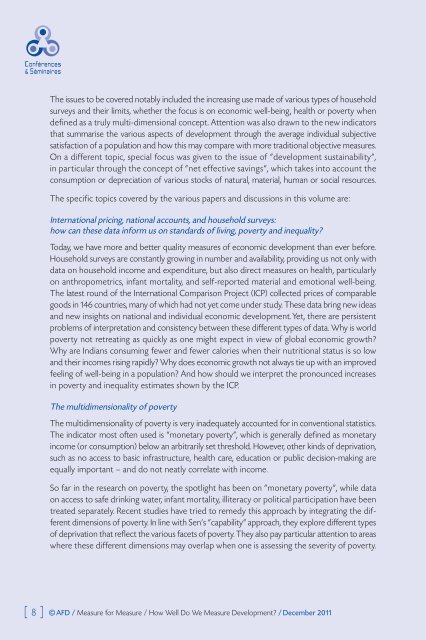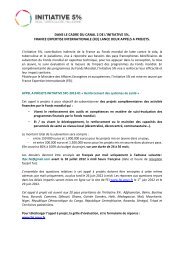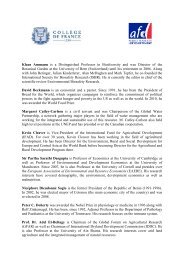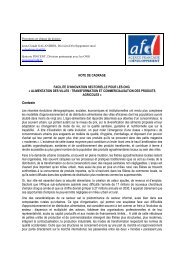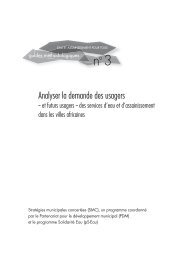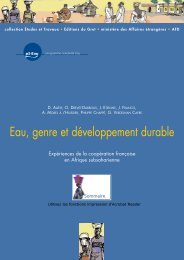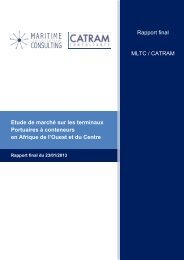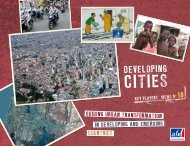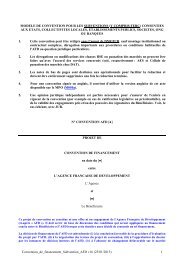Paris School of Economics - L'Agence Française de Développement
Paris School of Economics - L'Agence Française de Développement
Paris School of Economics - L'Agence Française de Développement
Create successful ePaper yourself
Turn your PDF publications into a flip-book with our unique Google optimized e-Paper software.
The issues to be covered notably inclu<strong>de</strong>d the increasing use ma<strong>de</strong> <strong>of</strong> various types <strong>of</strong> household<br />
surveys and their limits, whether the focus is on economic well-being, health or poverty when<br />
<strong>de</strong>fined as a truly multi-dimensional concept. Attention was also drawn to the new indicators<br />
that summarise the various aspects <strong>of</strong> <strong>de</strong>velopment through the average individual subjective<br />
satisfaction <strong>of</strong> a population and how this may compare with more traditional objective measures.<br />
On a different topic, special focus was given to the issue <strong>of</strong> “<strong>de</strong>velopment sustainability”,<br />
in particular through the concept <strong>of</strong> “net effective savings”, which takes into account the<br />
consumption or <strong>de</strong>preciation <strong>of</strong> various stocks <strong>of</strong> natural, material, human or social resources.<br />
The specific topics covered by the various papers and discussions in this volume are:<br />
International pricing, national accounts, and household surveys:<br />
how can these data inform us on standards <strong>of</strong> living, poverty and inequality?<br />
Today, we have more and better quality measures <strong>of</strong> economic <strong>de</strong>velopment than ever before.<br />
Household surveys are constantly growing in number and availability, providing us not only with<br />
data on household income and expenditure, but also direct measures on health, particularly<br />
on anthropometrics, infant mortality, and self-reported material and emotional well-being.<br />
The latest round <strong>of</strong> the International Comparison Project (ICP) collected prices <strong>of</strong> comparable<br />
goods in 146 countries, many <strong>of</strong> which had not yet come un<strong>de</strong>r study. These data bring new i<strong>de</strong>as<br />
and new insights on national and individual economic <strong>de</strong>velopment.Yet, there are persistent<br />
problems <strong>of</strong> interpretation and consistency between these different types <strong>of</strong> data. Why is world<br />
poverty not retreating as quickly as one might expect in view <strong>of</strong> global economic growth?<br />
Why are Indians consuming fewer and fewer calories when their nutritional status is so low<br />
and their incomes rising rapidly? Why does economic growth not always tie up with an improved<br />
feeling <strong>of</strong> well-being in a population? And how should we interpret the pronounced increases<br />
in poverty and inequality estimates shown by the ICP.<br />
The multidimensionality <strong>of</strong> poverty<br />
The multidimensionality <strong>of</strong> poverty is very ina<strong>de</strong>quately accounted for in conventional statistics.<br />
The indicator most <strong>of</strong>ten used is “monetary poverty”, which is generally <strong>de</strong>fined as monetary<br />
income (or consumption) below an arbitrarily set threshold. However, other kinds <strong>of</strong> <strong>de</strong>privation,<br />
such as no access to basic infrastructure, health care, education or public <strong>de</strong>cision-making are<br />
equally important — and do not neatly correlate with income.<br />
So far in the research on poverty, the spotlight has been on “monetary poverty”, while data<br />
on access to safe drinking water, infant mortality, illiteracy or political participation have been<br />
treated separately. Recent studies have tried to remedy this approach by integrating the different<br />
dimensions <strong>of</strong> poverty. In line with Sen’s “capability” approach, they explore different types<br />
<strong>of</strong> <strong>de</strong>privation that reflect the various facets <strong>of</strong> poverty. They also pay particular attention to areas<br />
where these different dimensions may overlap when one is assessing the severity <strong>of</strong> poverty.<br />
[ 8<br />
] © AFD / Measure for Measure / How Well Do We Measure Development? / December 2011


